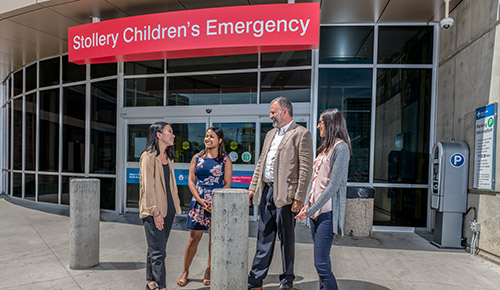
Members of the HeartsMap research team include (left to right) Mithra Sivakumar, Patricia Candelaria, Bruce Wright, Manasi Rajagopal and (not pictured) Amanda Newton.
When a child arrives at the Stollery Children's Hospital in the midst of a mental-health crisis, the emergency department's ability to quickly, yet accurately, assess the needs of the patient is key. "We're confronting how to deal with an influx of patients and utilize our resources the best we can," says Bruce Wright, associate professor and director of pediatric emergency medicine at the Stollery. Wright and his research team have embarked on a study to determine if an e-health tool called HeartsMap is the answer.
Developed by Quynh Doan-a health services researcher at the University of British Columbia-with input from University of Alberta associate professor Amanda Newton, HeartsMap is an electronic assessment tool that helps guide the care of pediatric patients with mental health symptoms. Hospitals and clinics across B.C. have been using the app since 2015, and with the U of A's reputation as a research site, says Wright, the Stollery was a natural choice as the first site outside of B.C. to test the tool. The goal, says Wright, is to prove that the tool is both useful and easy to use for clinicians and patients alike.
Doan, Wright and Newton secured a Canadian Institutes of Health Research (CIHR) grant in the spring of 2017 and had their research team hired and trained by January 2018. Alongside Wright and Newton, a research co-ordinator, a pool of research assistants and research nurses round out the team.
The Stollery is testing both arms of the tool: HeartsMap, used by trained professionals who run through the survey with incoming patients, collect the data and compare the results to their own assessments; and MyHeartsMap, used by patients themselves. They're also analyzing the usefulness of the app's extensive list of local resources, says Newton, for cases where ongoing support in the community is more appropriate than emergency care.
For clinicians, Newton says "The HeartsMap survey can keep you focused and keep the family focused," shortening the time required for assessment, an invaluable tool in the emergency department. For children entering the emergency department who agree to try MyHeartsMap, "It gives patients a way to give a voice to some of the stuff that's going on," says Newton, providing a way to objectively untangle what can be complex issues.
How will the team know if their study is a success? The research is still in its infancy, and Newton says that "So far, the success story for Bruce and the division would be the collaborative relationships that we've drawn upon to implement this and to make it work." Wright agrees. "We wouldn't be able to do this without the team," he stresses, highlighting both the relationships he and Newton have built through Pediatric Emergency Research Canada (PERC) with colleagues like Doan, and the internal collaborative atmosphere at the U of A.
For Wright, who plans to present their findings to PERC to build support for HeartsMap and MyHeartsMap among clinicians nationwide, if practitioners find it helpful enough to adopt in a variety of clinical settings-including as a screening tool during an annual checkup, for example-he'll know it's doing what it was meant to do.
Ultimately, says Newton, the biggest success story will be if children can say, "This helped me tell my story." And if HeartsMap can streamline ER visits and help get families where they need to be faster, "That's a win for everyone," emphasizes Wright. "The best patient care is always what we want," he says, "and if we can use research to direct care that's evidence-based, then even better."